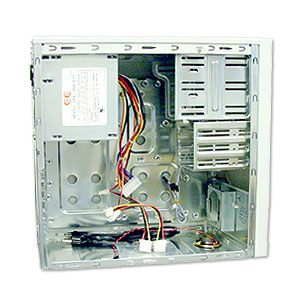|
The case
is where all the parts in the system unit are housed. The common
"form factor" for today's cases is ATX, however. Then there is the
"size" of the case. There are Micro-ATX, Mid-ATX, and Full-ATX.
Micro-ATX is smaller and therefore has a lower profile,
however they are not much fun to work on or upgrade. Mid-ATX
is a happy medium. Full ATX takes up A LOT of room. If
you are the techie type and want to see how much stuff you can cram into
one system this is the way to go.
When upgrading the case just
make
sure your motherboard
will fit into it. For instance, an ATX motherboard will not fit into
most micro ATX cases. On the other hand, most Mid and full size cases
will also hold a micro ATX motherboard.
Choosing a case isn't hard
once you learn about the form factors and power requirements of modern
systems. You can find bargain basement cases for as little as
$20.00. Wiz-bang all aluminum tool less entry name brand cases
(Coolmax) can run you as much as $300.00 or more. The more expensive
cases tend to have some nifty bells and whistles. Better cooling is
often part of the added value. Just make sure that your case has
enough "bays" to handle the hardware you want installed. Many
micro-ATX cases come with only one 5.5 inch and/or one 3.5 inch external
bay(s). While this may be fine for you current intentions, future
upgrades will most certainly include a new case. Swapping cases
isn't difficult, but it is time consuming.
|
|
 A Word On Power Supplies
Power supplies are often built into the
case. You need to make sure the power supply can handle the load you
plan to put on it. Smaller, less expensive systems, typically do not
need as much power as a high end system. Make sure to check with the
suppliers of your hardware for power supply recommendations.
More on
POWER |
